Horror through the Prism of Faith

Three chareidi women create a virtual reality film in the heart of Auschwitz
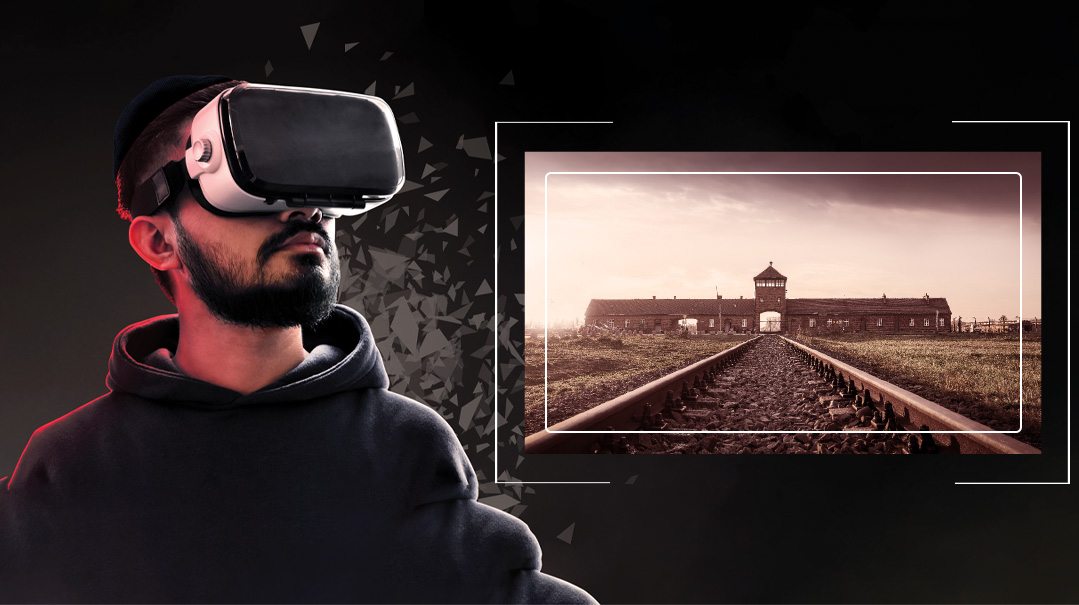
Photos: JVR360
“What will become of all the memories, are they to scatter with the dust in the breeze / Who will stand before the world, knowing what to say / when the very last survivor fades away”
(Journeys II, Abie Rotenberg)
It is 5:30 a.m. After four flights and a five-hour drive, we are finally entering the infamous gates of Auschwitz-Birkenau, treading the same path that millions have taken before us, never to return. My heart is beating a staccato, and the gates are locked behind us. They promised we’d be alone, and indeed, we are alone.
The drone lifts off and the monitor displays an aerial view of this Gehinnom spread out before us in all its diabolical horror. As if to highlight the irony, the spring weather brings placid blue skies, bright green grass, and deer with fawns, who would otherwise be frightened by the many tourists, leaping over the train tracks.
Exhausted and overcome with emotion, I want nothing more than to break down and weep, but we are struck by the responsibility we bear toward the martyrs whose memories we’ve committed to commemorating. We have three days, two filming teams, and a drone. I gather myself together, pack away my emotions, and spring into action.
Once we start filming, all doors open, figuratively, but also literally. Various clauses of the strict contract that we’d signed with the Auschwitz directorate are waived, and rooms that have always been locked are magically opened for us. We feel so clearly that Hashem is here with us, His Pillar of Cloud guiding us and smoothing out our path.
—from the diary of film producer Chani Kopolowitz
When chareidi film producers Miriam Cohen, Chani Kopolowitz, and Yuti Neiman decided to embark on a groundbreaking project to portray Auschwitz in virtual reality with 360-degree, 3D viewing, they encountered opposition from all the naysayers in the industry.
“Everyone discouraged us,” recalls Kopolowitz, whose team creates films for women and for schools. “Since VR is used mainly for gaming, apps, and simulations, we were advised that at the most, we could create an Auschwitz model in 3D that allows the viewer to explore the camp. But we wanted to do more than that, and in the end we decided to move forward with this tool that engages all the senses and that we knew had the power to convey the Holocaust narrative in all its horrifying reality.”
It was a question that had been bothering the women since they began creating kosher entertainment for the chareidi public over a decade ago: How to connect — on a deep and meaningful level — a new generation who’s used to seeing everything experientially, instantly, and in all its morbidity, with one of history’s most unthinkable atrocities?
Today, 78 years after Auschwitz was liberated, there aren’t many survivors left, and most young people have never even met a Holocaust survivor. The subject is taught in schools, but lacking a context, it often becomes distant and difficult to personally identify with, even for young people whose own family members perished.
While one of the most impactful ways the general education system in Israel teaches teens about the Holocaust is through guided tours of the death camps in Poland, they’re generally not an option in the chareidi sector.
That’s why the team knew their film, Triumph of the Spirit 360 (Nitzchah Haruach), a virtual reality film that presents the Holocaust through the prism of emunah, would be so important — and not only for young people or those who are religious.
Narrated by Rabbi Yisrael Goldwasser, a well-known lecturer, historian, and veteran tour guide to Poland, the film traces European Jewry from its thriving prewar days through its decimation in the Holocaust, followed by rebirth in the Land of Israel. Alongside a virtual 3D tour of the Auschwitz-Birkenau camps, the narrative is punctuated by stories — some told by the survivors themselves — that illustrate greatness of spirit under the most impossible circumstances.
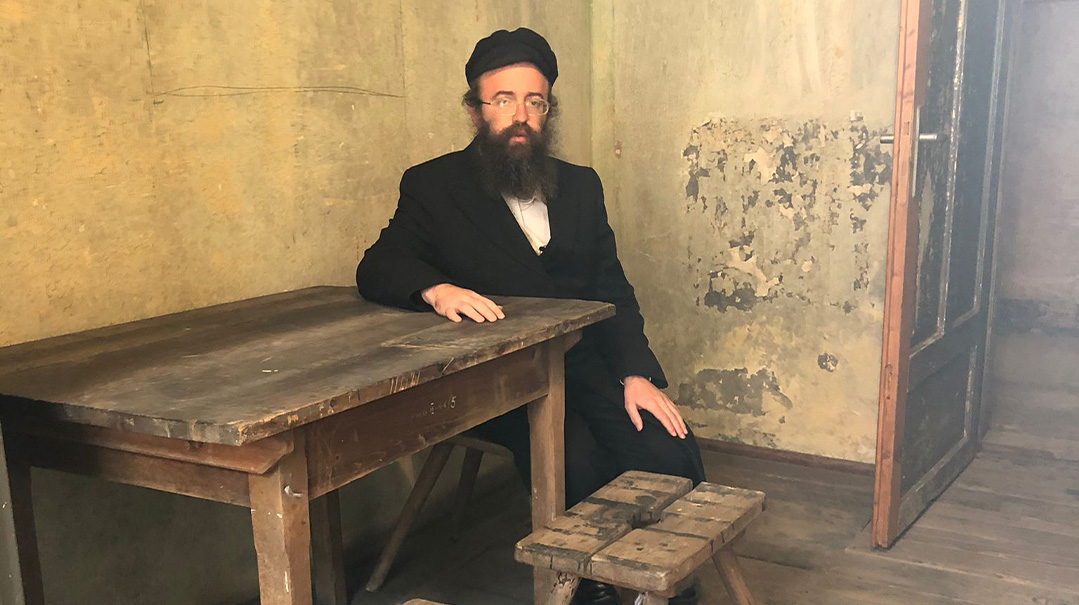
“I was sure this would be a pale reflection of the real thing. I couldn’t imagine standing there alone, talking to the camera.” Lecturer and historian Rabbi Yisrael Goldwasser originally doubted the project could achieve real impact. Then he entered Auschwitz and was overcome by emotion
Three Mothers
Chani Kopolowitz and Yuti Neiman met 18 years ago in their Bnei Brak seminary where they studied multimedia and video, and then went on to open a company creating and producing content geared to the chareidi community. Kopolowitz was the creative designer and videographer; Neiman — with her expertise in special effects — was the producer and editor. The two of them then teamed up with Miriam Cohen, an actress and director in many of the productions they filmed.
“We realized that as a threesome, we were a fantastic team, and before long, Miriam became an integral part of the studio and a full partner,” says Neiman.
The three women are devoted mothers of large families, with a lot of babies and young children between them. Still, each of them had a consuming interest in the Holocaust from a young age. Yuti Neiman is the third generation to survivors who evaded the fate of their extended family Hy”d. “I’ve read a huge amount of Holocaust literature, including the memoirs my grandmother and her sisters wrote about their miraculous rescue. The Holocaust was always a part of our family history. For years, I had an intense desire to travel to Poland and visit the camps, and I always knew I’d do it someday.”
Chani Kopolowitz would spend hours in the Ginzach Kiddush Hashem Holocaust archives from a young age, poring over photos and stories. “I was captivated by the fact that our rebbe, the Slonimer Rebbe Rav Shlomo David Yehoshua Weinberg Hy”d, decided to stay with his community and die al kiddush Hashem.”
Miriam Cohen, for her part, didn’t hear much about the Holocaust from her Moroccan parents who’d immigrated to Canada, yet for as long as she can remember, she was inexplicably drawn to Holocaust history.
When the three encountered VR technology in the course of their work, it was clear to the women that it could be a significant vehicle for Holocaust education. The typical VR model includes a headset for 3D viewing and earphones, with the participant retaining full control via a control panel or joystick. Generally, the technology is used for sci-fi, futuristic entertainment that doesn’t last more than 15 minutes. The women, defying the industry naysayers, harnessed the technology for a full-length, historical documentary in a realistic (not animated) environment.
“Unlike a static display at a museum, or even a film watched on a screen, VR involves the viewer with all his senses, putting him in the center of the frame, thus fostering emotional involvement — a vital ingredient for presenting to today’s generation the events in the full historical context,” Kopolowitz explains. “It was a complicated proposition. We had no financing, no tech support, and no references to fall back on because no one had ever tried this kind of a project before.”
But that was no deterrent. The women purchased a small, simple model VR camera and proceeded to learn the ins and outs of 360-degree photography. For the actual filming at Auschwitz, they would need a professional team and equipment, but there were so many obstacles along the way that when Triumph of the Spirit 360 finally emerged, it felt like an open miracle.
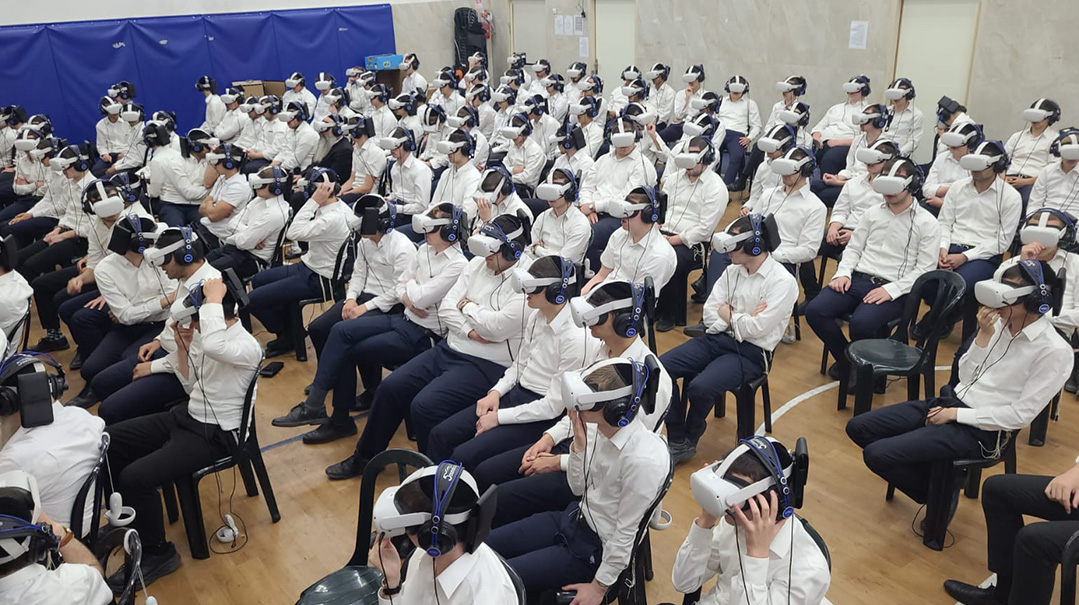
We Needed a Prayer
“Finally, we thought we were on our way, when Covid struck and the world came to a standstill,” Miriam Cohen recalls. “For the first time in its postwar history, Auschwitz was closed to visitors. We figured we’d have to wait it out until after the lockdown, but soon it dawned on us that the pandemic was actually our golden opportunity.”
With some two million tourists visiting the Auschwitz-Birkenau camp each year, it’s essentially impossible to film without anyone in the vicinity. “It was only because the site was closed that we were able to produce something so authentic and so very potent that enables viewers to be there alone with themselves,” says Neiman.
But that almost didn’t happen. “As producers, we’re accustomed to various venues — such as our local health clinic for example — doing us a favor and allowing us to film, and we thought Auschwitz would be no exception,” relates Kopolowitz. “But nothing could have been further from the truth.”
The women began through the regular channels, Yad Vashem and Ginzach Kiddush Hashem, but no one was able to help: Auschwitz has a non-negotiable no-filming rule. Both the Polish ambassador to Israel and the Israeli ambassador in Poland discouraged them, too, saying that even world-renowned director and producer Steven Spielberg had been unable to procure authorization to enter the camp when filming the award-winning Schindler’s List. (The famous shot of the train entering Auschwitz was actually taken outside of the camp, with the train running in reverse, and then edited to make it look as if it were moving forward.)
When all seemed lost, an acquaintance sent Miriam Cohen the home phone number of a woman named Dorota, the head of the Auschwitz board of directors. Dorota spoke no English, only Polish and French. But that was fine for Miriam, who was fluent in French thanks to her Canadian background. She succeeded in communicating her message, and Dorota was moved by the concept, no less by Miriam herself, and told her to email an outline of the project.
“We quickly wrote up the document, and with a little help from Google, translated it into Polish and sent it off,” Chani Kopolowitz relates. “Two days later, Dorota called us. She’d invited the entire board of directors to convene and discuss our request. But she warned us not to get our hopes up, since filming was forbidden at the site, and VR, all the more so. Nevertheless, this non-Jewish official urged us to do what we Jews are known for: She told us to pray.”
And so, the three women turned off their computers, lit candles l’illui nishmas the kedoshim, and prayed.
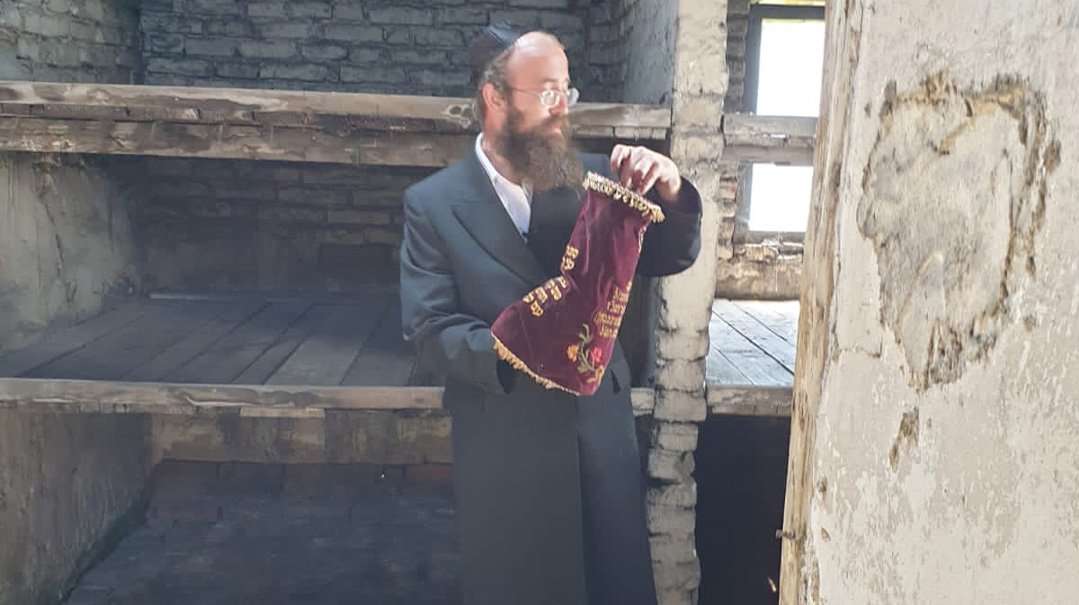
“We felt that we were on the cusp of something very fateful. We completed Sefer Tehillim twice. Yet the candles went out, and still Dorota hadn’t returned our call,” says Yuti Neiman.
Four and a half hours later, Dorota was on the line. “All this time, I fought for you!” she said, and concluded triumphantly, “For the first time ever, we will open the camp for filming. You have three days. Come at the beginning of next week.”
After the initial exultation, the women paused. How could they travel to Poland with Covid restrictions so uncertain? Europe’s borders were opening and closing with seeming randomness, and there were almost no outgoing flights. After three sets of plane tickets were purchased and then canceled due to border closures, the fourth was a charm. It would take three connections, but they’d reach Warsaw.
But the challenges were just beginning. Polish protocol obligated all incoming tourists to quarantine for 48 hours. Yet somehow, when they arrived, all the other passengers were quarantined, while their group was allowed to continue their journey — a five-hour drive to Auschwitz.
The most formidable obstacle ultimately turned out to be the greatest blessing. “We’d searched high and low for a company with the knowhow and equipment to perform the 360-filming. Ironically and embarrassingly, the only company we’d found that had adequate experience and expertise was German,” says Kopolowitz. “We weren’t happy about it, but we had no other choice. And then, after dozens of Zoom meetings, translated documents, and less than 24 hours before our flight to Poland, they called off the contract.
“In desperation, we tried to find a replacement but to no avail. Finally, in the middle of the night, just five hours before our scheduled flight, we discovered Yochai, an expert in VR photography who, it turned out, had always wanted to film Auschwitz in 360 degrees — in fact, he’d even once set up a meeting with Yad Vashem about it. We quickly signed a contract, and he drove straight to the airport.”
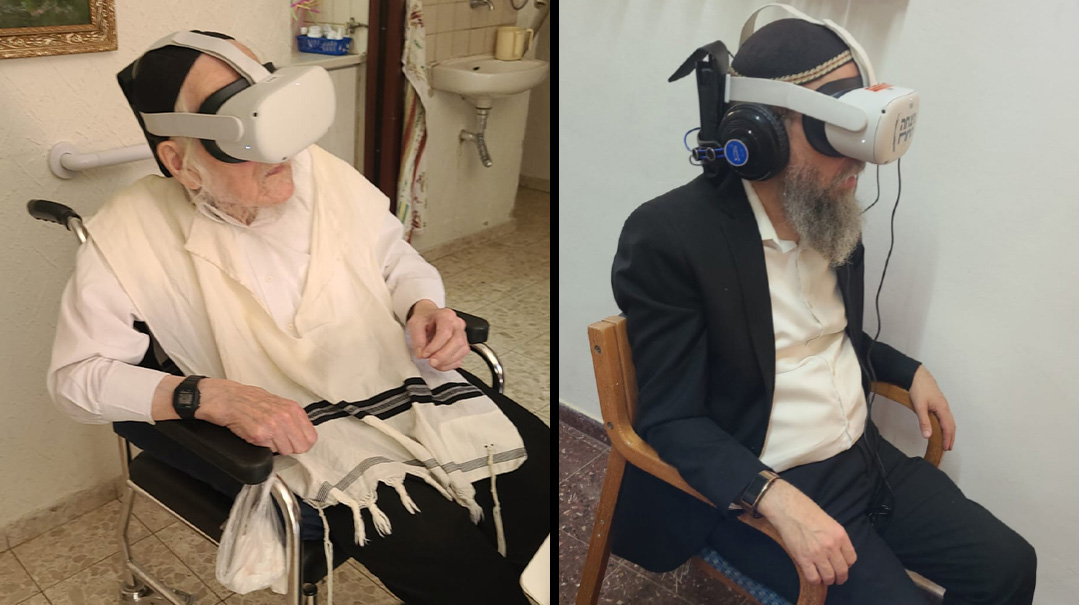
No Distractions
Rabbi Yisrael Goldwasser, a Gerrer chassid, is a sought-after lecturer and historian who often accompanies groups to the death camps in Poland.
“I didn’t start out as a Holocaust expert though. I speak on various subjects, but I noticed that whatever topic I choose somehow always circles back to the Holocaust,” he says. “Young people, yeshivah bochurim — they want to hear about the kiddush Hashem in the Holocaust. It’s emotionally charged, it’s inspiring, it’s real — and it obligates us. Many concepts and mitzvos somehow find their fullest, strongest expression through the Holocaust — the ahavas Torah in the bunker in Warsaw, the succah they cobbled together in Auschwitz….”
When Rabbi Goldwasser was initially approached about the idea of accompanying the VR journey to Auschwitz, he was skeptical. “I’ve guided many groups to the Auschwitz-Birkenau camps over the years, and I was certain that this filmed version would be a pale reflection of the real thing. I couldn’t imagine standing there alone, talking to the camera, having to muster up emotion when I didn’t have the group behind me.”
Yet what he experienced during filming was altogether different. “Standing there alone, I could feel so strongly the presence of the holy souls of the kedoshim that permeate this place. Reciting Shema Yisrael was an indescribably moving experience for me. I think that came across to viewers as well.”
Rabbi Goldwasser had been under the impression that people who had already been on tours to Auschwitz would be less inclined to find interest in Triumph of the Spirit 360, but he was repeatedly proved wrong. The bird’s-eye view of the camp, the music (with an original soundtrack by Yehuda Kunsman, the baal teshuvah son of world-famous jazz artist Roman Kunsman), and the multi-sensory experience gave them a new perspective. “People approach me all the time saying that the virtual experience was even more meaningful for them than the physical visit. During a trip, as sobering as it may be, there are constant interruptions: your phone, rest stops, the other tourists. By contrast, with VR, the viewer is able to be completely present and immersed, without any distractions,” he says.
Rabbi Goldwasser was especially gratified at how Triumph of the Spirit 360 affected secular audiences. “I was doubtful that they’d be receptive to my words about emunah and bitachon, but the overwhelming response was very emotional and positive. Look, when do non-religious Israelis, especially young people, have the opportunity to hear the chareidi perspective on the Holocaust? To learn about the mesirus nefesh of the kedoshim for the sake of performing a mitzvah, or to save a fellow Jew? I think they were moved by the sheer authenticity of the narrative.”
When they first produced Triumph of the Spirit 360, Cohen, Kopolowitz, and Neiman intended it primarily for a chareidi audience, but have since recognized the project’s inestimable value for all audiences.
Between July 2021 and August 2022, some 50,000 people, of all ages and from the full spectrum of Israeli society, have viewed the film. It has since traveled to the UK, and will soon be all over the Jewish world.
Rav Meir Luria, Rosh Kollel Briesch, said that “a person’s avodas Hashem before and after seeing Triumph of the Spirit 360 is not the same.”
Holocaust survivors who have viewed the film were also moved by the initiative. Auschwitz survivor Devora Berger says she’s seen many Holocaust films, but that this was different. “There were moments when I couldn’t stop my tears. I know that fence…. Oy, there are the pits, that’s where my parents are! And the piles of shoes. I looked to see if I could find my shoes or my sister’s shoes with the diamond hidden inside….”
After the screening, the producers encourage viewers, especially high-schoolers, to open a dialogue. “It’s important that they have the opportunity to discuss their experience and process their feelings,” says Cohen. “And I’m always amazed anew at the responses. Students and teachers from the most left-wing enclaves and unaffiliated groups are very open to the message. We’re not coming to preach or to lecture — we’re just telling them a story.”
For many, the film arouses feelings of Jewish pride, connection to the Jewish people, and a desire to explore their own place within Am Yisrael. Many non-religious viewers have even resolved to take on a mitzvah for the first time.
“We realized that if our original mission had been to create an educational tool about the Holocaust, we came out with something much greater,” says Kopolowitz. “The stories of spiritual triumph meet each person where they are and infuse strength and meaning into their own lives. But even more significantly, it serves as a bridge between the many sectors of Jews. It unifies us all.”
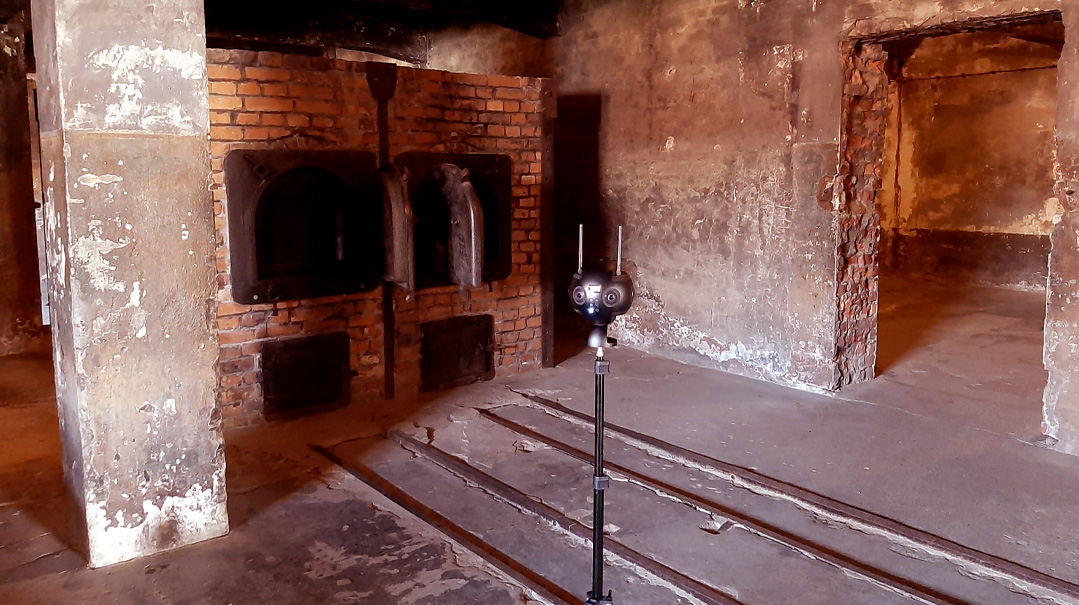
STITCHED WITH HUMILITY
Chani Kopolowitz kept a diary of the progress and setbacks in her team’s effort to actually make Triumph of the Spirit 360 happen. And just when things were finally looking up….
The Thursday before our trip, we were all sitting in the studio, proud as peacocks, high-fiving each other. We’d done it! We’d figured out the tech, opened Auschwitz, obtained flights, got the best filming company in Europe…. Everything was good to go, and then, within minutes, it all collapsed like a house of cards.
Auschwitz sent us a furious email that they hadn’t received our payment for opening the site. They were canceling our agreement, they said, and wouldn’t renew it in the future after we’d put them to so much trouble. Then, our travel agent called to tell us that our flight was no longer relevant as the border to our destination had just been sealed. If that wasn’t bad enough, the German VR film company that we’d signed with threatened that if we didn’t send all the payment in advance they would cancel (which they did a few hours before our flight), and then they simply stopped answering.
To sum up: There was nowhere to go, no way to go, and no one to do the filming. Within minutes, we’d been thrust from the pinnacle to the depths.
We began to say Tehillim, we gave tzedakah, we made phone calls, but… nothing. After a few frustrating hours, I told Yuti and Miriam that I felt Hashem wanted something different from us.
Our hopeless situation brought to mind a chassidic tale about a tailor who was commissioned by the poritz to sew an elegant wardrobe for his family. The tailor boasted to his countrymen about his great talents that had landed him such a lucrative job. After many weeks of intensive labor, the time came for the first fitting, and the tailor proudly brought out all the garments. The poritz had barely tried on the first jacket, when he threw it down in a rage, shouting that it didn’t fit well and that if the tailor couldn’t deliver what he’d promised, he’d be cast into the dungeon for life. Shocked and terrified, the tailor went to his rebbe and sobbingly told him the story.
The Rebbe consoled the tailor and instructed him to take apart all the seams of the garments, and then to resew them. The tailor didn’t understand how that would help, but with fear and trepidation, he did as he was told. A week later, the poritz came back and tried on the clothing, and lo and behold, this time he was so delighted he appointed the tailor to work for him on a permanent basis.
Confused, the tailor returned to the Rebbe who explained, “The first time, you sewed the garments with arrogance, and that’s why you didn’t succeed. The second time, you sewed with humility and a broken heart.”
The message was clear. We’d been drunk with victory at all that “we” had done and had left Hashem out of the picture. And where was our gratitude at the incredible siyata d’Shmaya and the awareness of our own helplessness?
I couldn’t help but notice how fitting the metaphor was for our work: Fusing together the six frames taken by the VR camera into one file that can then be edited is called “stitching.” We immediately took it upon ourselves to continue “stitching with humility.”
When we parted at two a.m., we still hadn’t made any progress, but our hearts were light from the kabbalah that we’d taken upon ourselves.
The following day, while the three of us were in our respective kitchens preparing for Shabbos, all the issues resolved themselves, without any intervention on our part. The Auschwitz Museum sent us an email with an explanation and an apology (the issue had been with the foreign currency exchange); the travel agent found a different route for us; and even the German company came around (although, they ultimately canceled, leading us to Yochai, a religious, G-d-fearing Jew, to do the filming).
Since that vital lesson, we endeavor at all times to advance with humility and never forget for a moment Who is orchestrating our success.
(Originally featured in Mishpacha, Issue 946)
Oops! We could not locate your form.







